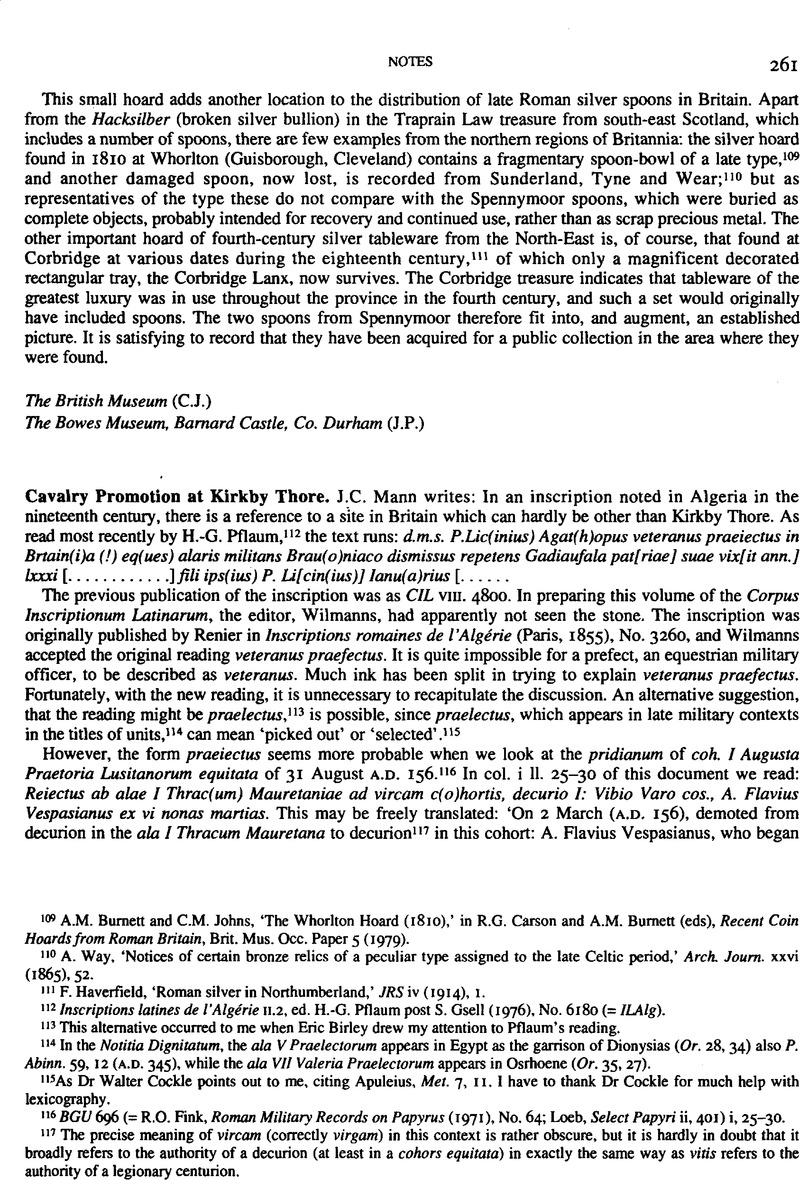Published online by Cambridge University Press: 09 November 2011

112 Inscriptions latines de l'Algérie 11.2, ed. H.-G. Pflaum post S. Gsell (1976), No. 6180 (= ILAlg).
113 This alternative occurred to me when Eric Birley drew my attention to Pflaum's reading.
114 In the Notitia Dignitatum, the ala V Praelectorum appears in Egypt as the garrison of Dionysias (Or. 28,34) also P. Abinn. 59,12 (A.D. 345), while the ala VII Valeria Praelectorum appears in Osrhoene (Or. 35,27).
115 As Dr Walter Cockle points out to me, citing Apuleius, Met. 7, 11. I have to thank Dr Cockle for much help with lexicography.
116 BGU 696 (= R.O. Fink, Roman Military Records on Papyrus (1971), No. 64; Loeb, Select Papyri ii, 401) i, 25-30.
117 The precise meaning of vircam (correctly virgam) in this context is rather obscure, but it is hardly in doubt that it broadly refers to the authority of a decurion (at least in a cohors equitata) in exactly the same way as vitis refers to the authority of a legionary centurion.
118 For the correct form Bravoniacum see A.L.F. Rivet and C. Smith, The Place-Names of Roman Britain (1979), s.v.
119 Dobson, B. and Mann, J.C., Britannia iv (1973), 191–206.CrossRefGoogle Scholar
120 J.C. Mann, Legionary Recruitment and Veteran Settlement during the Principate (1983), tables 1–4.
121 III Augusta early declared for Severus, hence its receipt of the titles pia vindex.
122 Herodian, for what he is worth, refers to Severus ‘drawing troops from all sides’ and comments on the size of the force he collected (III. 14. 3–4). CIL VI. 2464 = ILS 2089 with CIL VI. 1057 indicates the presence of men from the Praetorian Guard, while CIL XIII. 3496 = ILS 9123 and RIB 2216 may suggest the presence of a detachment of XXII Primigenia from Upper Germany. A detachment from III Augusta would hardly be out of place.
123 JRS lvii (1967), 205 No. 16 and pl. xix, 1Google Scholar: the reference to the men from the two Germanies is difficult to decipher on the stone. It either reads EXER, for EXER(citui), or EXPL, for EXPL(oratorum). In either case, there is a strong suggestion that these men have been brought over to fight, not merely (e.g.) for construction work, although reinforcement in the aftermath of disaffection is possible, as suggested by Birley, E., Epigraphische Studien 4 (1967), 103–7Google Scholar. More recently a further inscription has emerged at Piercebridge referring to a man from Germania Superior: Britannia xvii (1986), 438, No. 20 and fig. 7.Google Scholar
124 Review of RIB in Bonner Jahrbücher clxvi (1966), 642–3.Google Scholar
125 Here reverting to Collingwood's reading DOM[u in preference to Alföldy's DON[avit.
126 There are of course in the frontier area a large number of undated inscriptions set up by men described simply as Germani (RIB 920, 1525 and 2063), or with German names (RIB 926), or as specifically coming from Upper Germany (RIB 1620 and 1665). Conceivably one or more of these inscriptions may date to c. A.D. 217.
127 Mann, op. cit. (note 120), 18. (It is not very likely, however, that Agathopus began his service in III Augusta.) This recruitment of citizens to the alae and cohorts of Numidia may have some connection with the absence of military diplomas issued to men of that army.
128 Acta. Cons. Carth., A.D. 256. Unfortunately, Agathopus' use of patria does not quite clinch city status, nor do the sacerdotes who appear in ILAlg 6176 and 6178; for what it is worth, Procopius (Bell. Vand. 2.15) refers to the territory of Gadiaufala.
129 ILAlg 6179.